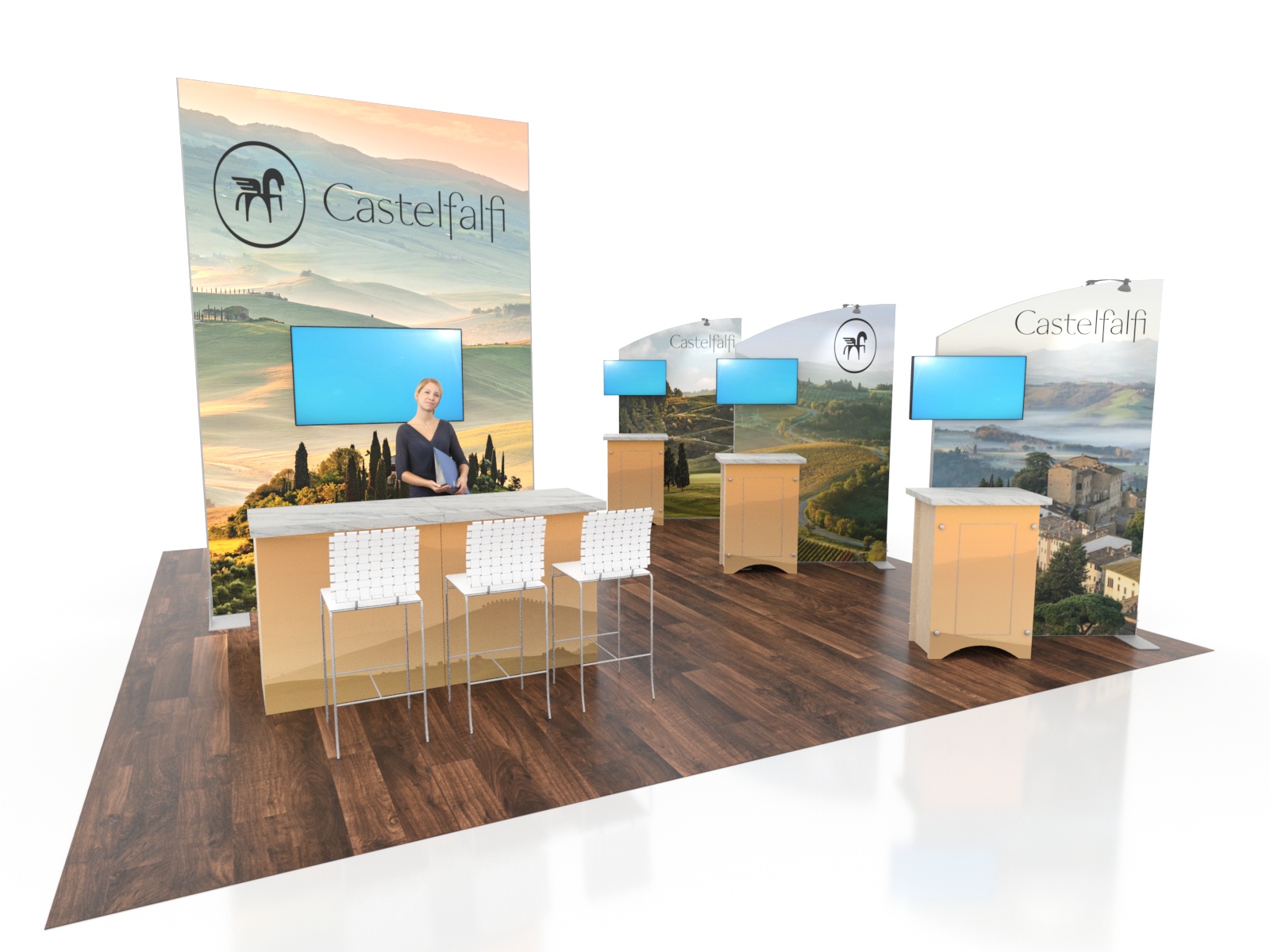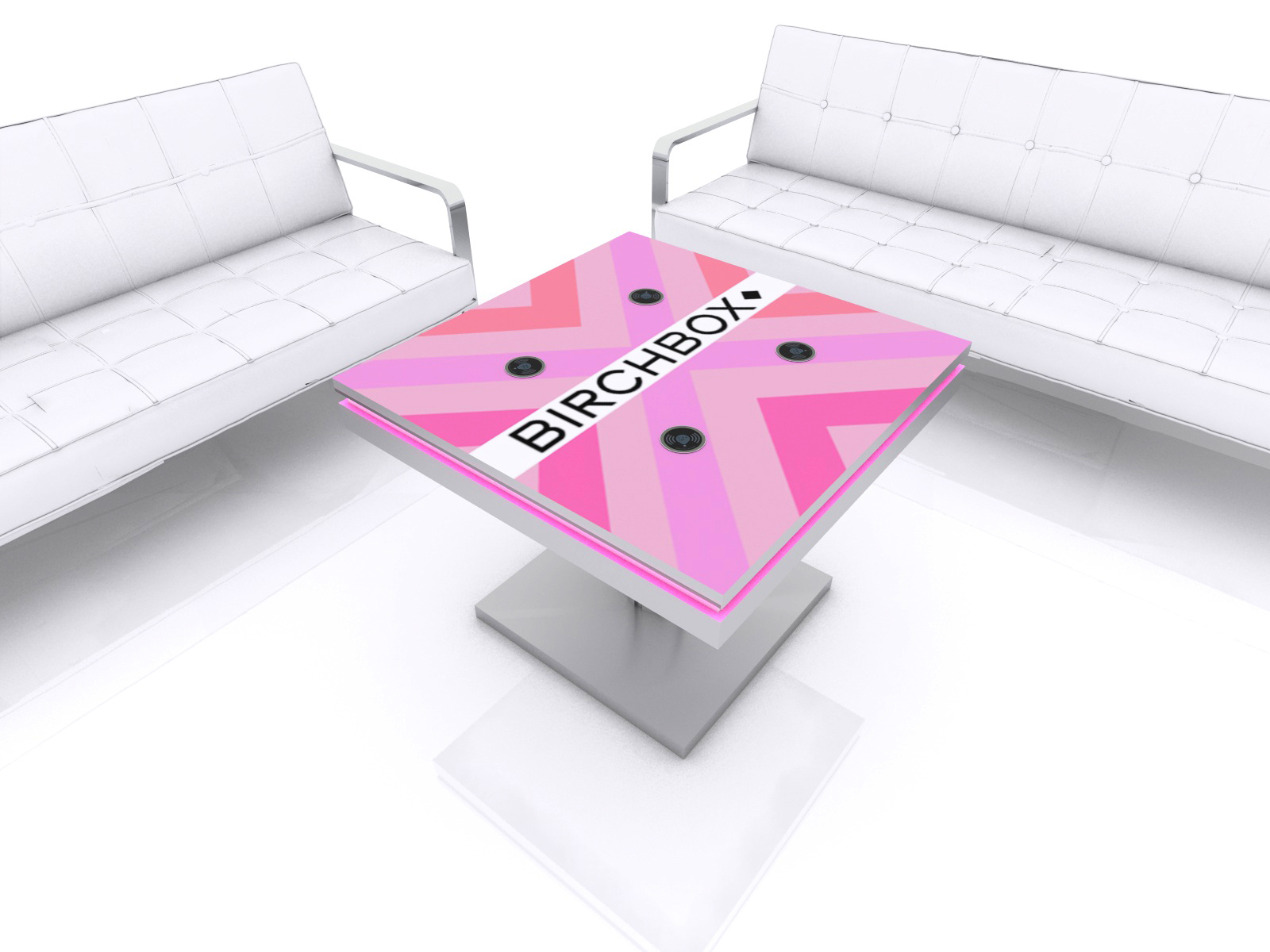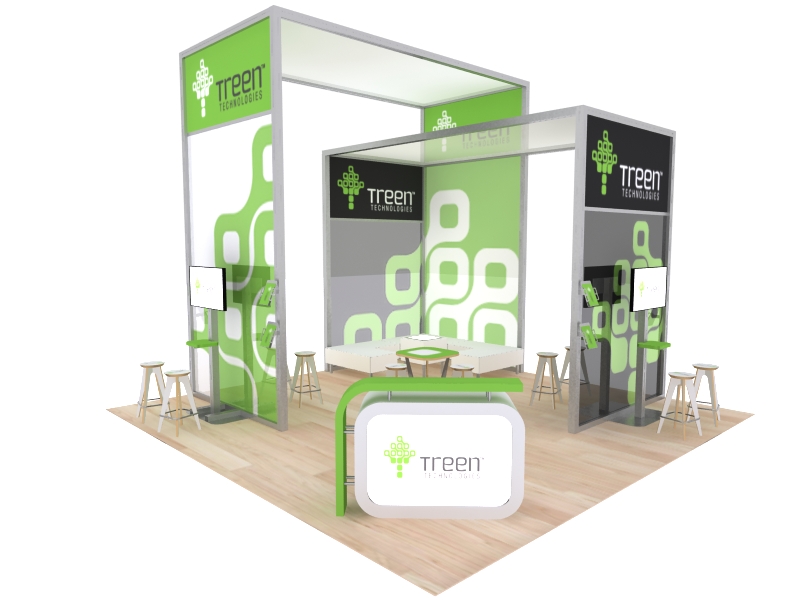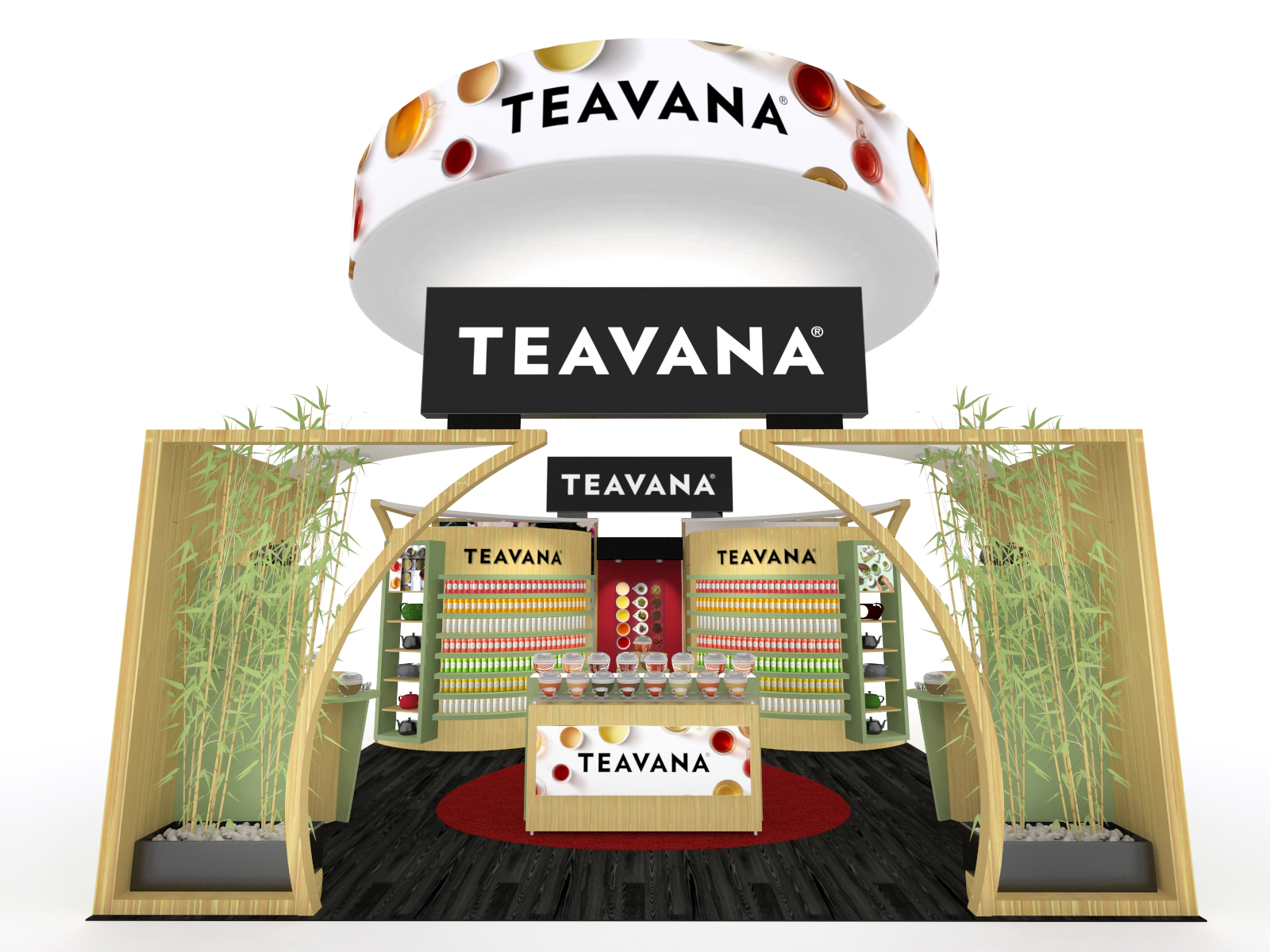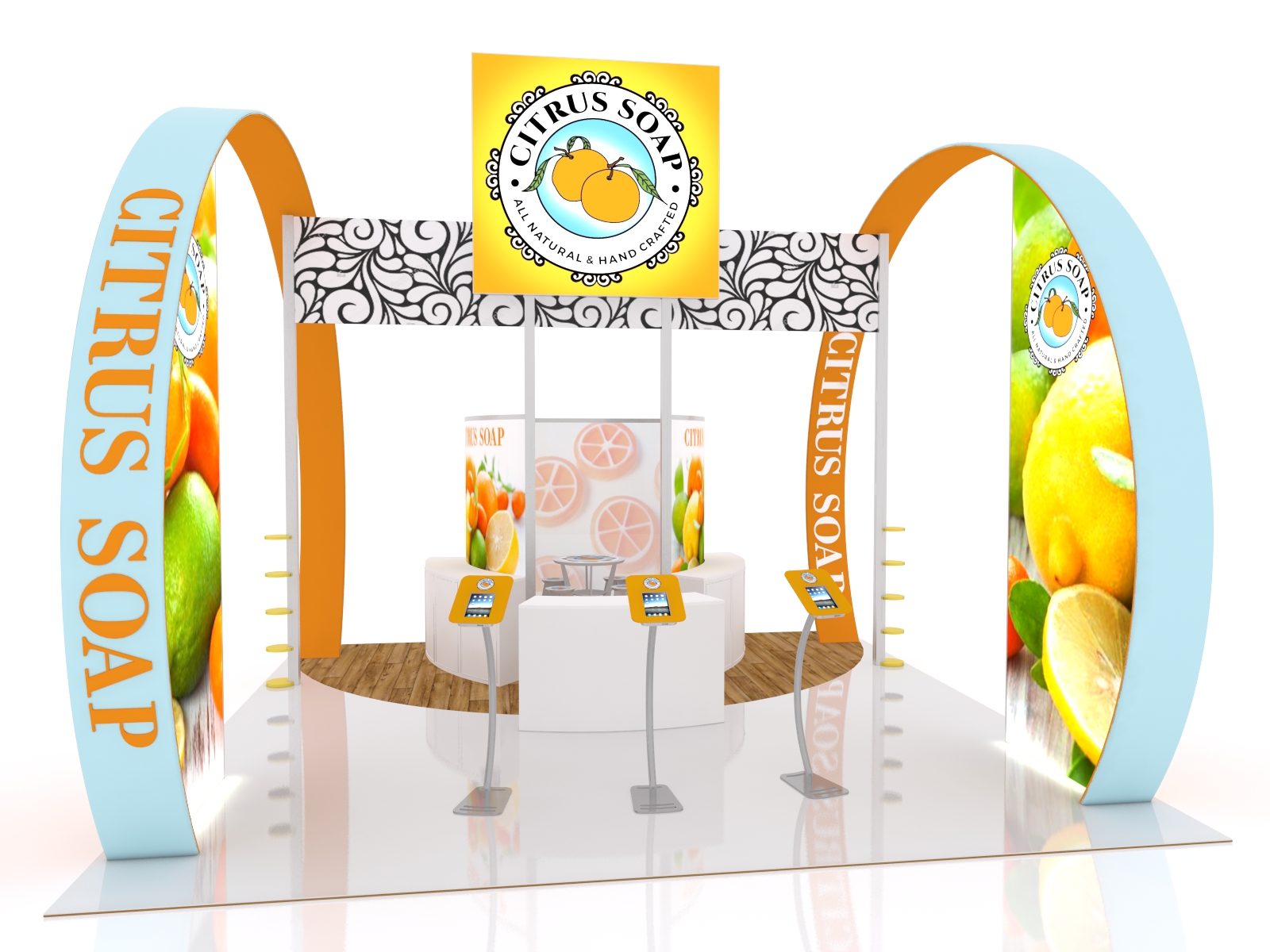Do you want to know the single worst trade show exhibit marketing advice?
“Don’t worry about it. The show organizer will take care of getting attendees to the show. You just have to look good, and exhibitors will flock to your booth.” In other words, if you build it, they will come. While that may have been true in 1967, that advice is no longer true today.
Trade show success requires more than a “pretty display.” It requires specific goals, an executable plan, and a range of trade show marketing materials to maximize your return on investment. Trade show marketing is (not surprisingly) “marketing.” The tools may differ but not the steps required to attract and engage potential clients. For the sake of this article, we’ll assume you are familiar with buying an exhibit or display. Trade show marketing materials will be our sole focus.
We’ll review the top trade show marketing materials and how to incorporate them into your exhibition strategy.
Table of Contents
- Overview
- Essential Marketing Materials
- Engagement Tools
- Vendor Strategies
- Choosing the Right Materials
- Booth Strategies
- Distribution Tips
- Security & Safeguards
- Why Work with Us
Trade Show Marketing Materials: An Overview
What is trade show marketing? Trade show marketing is a strategic approach to promoting your business and generating leads at industry-specific events. It focuses on attracting potential customers, building brand awareness, and networking with other industry professionals. Here are the four key components:
- Target Audience: Trade shows gather a concentrated audience highly interested in a particular industry. This targeted environment allows you to connect with qualified leads who are already receptive to products and services like yours.
- Interactive Experience: Unlike traditional advertising, trade shows provide a space for face-to-face interaction. You can showcase your products or services through demos, presentations, and discussions, fostering a more memorable and engaging experience for attendees.
- Multifaceted Approach: Effective trade show marketing goes beyond just having a booth. It encompasses a variety of tactics like pre-show email marketing, social media promotion, eye-catching booth design, informative trade show marketing materials, and well-trained staff to represent your company.
- Measurable Goals: While brand awareness is a benefit, most businesses have specific goals for their trade show participation, such as lead generation, sales pipeline growth, or new customer acquisition. By tracking metrics like booth traffic, lead capture forms, and post-show follow-up interactions, you can measure the success of your trade show marketing efforts.
By planning a comprehensive strategy and using the right trade show marketing materials, businesses can maximize their return on investment from trade show participation. Trade show marketing materials are the connective tissue between your booth, your message, and your leads.
7 Essential Marketing Materials for Trade Shows The Core Elements
Let’s start with the basics whether you have a 10 x 10 or a 40 x 80 space on the show floor. These are essential items regardless of your budget or your size. You’re probably already doing all of these, but let’s put a bit of a spin on each one.
1. Business Cards
While business cards may have lost some of the luster of yesteryear, they’re still essential at any trade show. Clients will request them as a mental reminder of who they visited on the show floor. Off the show floor, business cards are essential for social events, educational seminars, and random discussions with strangers while getting coffee. Well-designed business cards can still make a powerful impression and serve as a tangible reminder of your brand.
2. Digital (or NFC Cards) and Sustainable Business Cards
Digital business cards come in several forms, each offering unique advantages for sharing contact information and showcasing your brand. Eco-friendly business cards prioritize environmental sustainability in their materials and production. The goal is to reduce waste, conserve resources, and minimize the carbon footprint.
Digital Business Card and NFC Card Options
- App-Based Digital Business Cards: You create and manage your digital business card profile through a dedicated app. This profile acts as a miniature website or landing page for your contact information. It’s generally shared through a QR code, direct link, or email signature.
- NFC (Near Field Communication Business Cards): These are physical cards (or stickers, keychains, etc.) with a small NFC chip embedded within them. When tapped against an NFC-enabled smartphone (most modern smartphones), the chip transmits a pre-programmed link or contact information to the phone.
- Wallet-based Digital Business Cards: These are digital business cards that can be stored directly within a smartphone’s native digital wallet app (Apple Wallet for iPhones, Google Wallet for Android). Typically includes essential contact information and often a QR code that links to a more comprehensive digital profile (like the app-based ones).
Eco-friendly Business Cards (Physical but Sustainable)
- Recycled Paper Business Cards: Made from post-consumer waste, reducing the demand for new trees.
- Seed Paper Business Cards: These unique cards are embedded with seeds (wildflowers, herbs, vegetables). After use, the recipient can plant the card, and it will grow into plants, completely biodegrading the paper.
- Bamboo or Cotton Fiber Business Cards: Made from sustainable and rapidly renewable resources like bamboo or cotton linters (a byproduct of the textile industry).
- Kraft Paper Business Cards: Often made from recycled content, Kraft paper has a natural, earthy look and feel.
- FSC-Certified Paper: While still tree-based, FSC (Forest Stewardship Council) certification ensures the paper comes from responsibly managed forests.
Eco-friendly and digital business cards have a high-tech appeal. They’re Ideal for younger or tech-savvy audiences. Digital business cards generally pair with lead generation apps and link directly to your website, portfolio, or digital brochure
3. Branded Apparel
Branded apparel is clothing that features a company’s logo, slogan, or other branding elements. For attendees, it’s a convenient reminder of your company before, during, and after show hours. It can also set the cultural tone for your company. Are you casual? Formal? Fun? Finally, branded apparel makes it easy for your booth staff to know what to wear each day.
4. Trade Show Promotional Products
Also known as swag, tchotchkes, or freebies, promotional products are any merchandise branded with a company’s logo or slogan to promote a brand, corporate identity, or event. Is it a requirement? No. Can it be a distraction? Yes. However, a promotional product that reinforces your marketing strategy and brand can have a financial impact that greatly exceeds the cost of the giveaway.
5. Trade Show Brochures (PDFs)
Generally, stacks of paper brochures on the show floor are rare these days. Most attendees don’t want to carry paper flyers, brochures, or catalogs. However, a few samples can be helpful when reviewing products and services. Not everyone wants to click through an online demo or website. Be sure to have PDFs available which can be emailed directly from your lead management software.
6. Lead Retrieval/Management
Electronic lead retrieval software is a must for any exhibitor at an industry trade show. Not only does it capture leads effortlessly, but it also allows you to send a thank you, product information, and even a questionnaire automatically from the show floor. In addition, modern lead retrieval software integrates with most CRM systems so documenting the sales process has never been easier.
If you do more than a handful of shows a year, choose a lead retrieval software provider that’s independent of the show. That way you don’t have to recreate the wheel each time and you have a data history of all your leads.
7. Branded Landing Pages
Branded landing pages are one of the most effective tools for trade show marketing. By directing QR codes, printed materials, and giveaways to a focused, event-specific page, you can capture leads, deliver targeted content, and measure real ROI.
Unlike a homepage, a landing page is built around one message and one call to action—no distractions, just results. You can tailor messaging to the audience, highlight show-specific offers, and include forms that collect the info your sales team actually needs.
These pages also keep the conversation going after the booth. Attendees can watch demo videos, explore product details, or download resources at their convenience. And with built-in tracking, you’ll know exactly who engaged, how they found you, and what actions they took.
It’s a simple way to extend your booth online, build credibility, and turn foot traffic into qualified leads.
5 Trade Show Marketing Tools for Engagement
There’s the exhibit… and then there’s everything else in the booth. The “everything else” is just as important as the exhibit to create a relaxing, interactive, and informative experience for your prospective clients. Consider the following additions to increase your attendee engagement.
1. Trade Show Banners & Posters
Banner stands and posters often get a bad rap because they’re used as a replacement for a more professional-looking display. In a larger exhibit, banner stands are ideal for highlighting features and benefits, as directional signage, and for targeted messaging about an event, a product, a promotion, or even your company’s culture. A high-quality banner stand or poster can fill in the gaps that larger format graphics miss.
2. Interactive Kiosks
To maximize the number of touches at your next business event or trade show, you need to increase your odds of connecting with the ideal client. However attracting visitors can be challenging in that chaotic environment. A well-designed touch table or interactive kiosks display can turn a “vanilla” presentation into dynamic content.
3. Trade Show Furniture
Make today’s trade shows, events, and meetings more productive by creating interactive environments with functional rental furnishings. Effective meetings and conferences facilitate learning, engagement, and networking. No matter the occasion, our rental furniture delivers style and service to help you create a “wow” experience that will impress your clients.
4. Charging Stations
Versatile charging stations are the modern rock stars on the trade show floor, drawing crowds and attracting fans. Available in a variety of contemporary designs, including bistro, coffee, and end tables in round, square, and custom shapes. Or choose a Power Tower or a custom counter with locking storage
5. Food & Drinks
This one is tricky, especially at North American trade shows. In Europe, many exhibitors treat attendees as guests, serving food and beverages at tables. North American exhibitors take a more relaxed approach. They’re more likely to serve virgin margaritas, chocolate chip cookies, or soft-serve ice cream.
8 Vendor Marketing Materials for Lasting Impressions
There’s a reason exhibitions and events are called face-to-face businesses. It’s all about people connecting with people. Exhibitors have multiple ways to ensure those interactions are memorable. Today’s attendees crave “experiences” and exhibitors have embraced that challenge. Here are (5) vendor marketing strategies to create lasting impressions.
1. Pre-Show Mailers
Trade show marketing depends on attracting the right attendees to your booth and qualifying them as viable future customers. Unfortunately, far too many exhibitors assume the show organizer is solely responsible for attracting trade show attendees. Successful exhibitors drive traffic to their booth before and during the show. Pre-show mailers, often known as direct mail campaigns, are an underutilized marketing tool.
Pre-show Mailers:
- Cut Through the Digital Clutter
- Increase Brand Awareness and Recall
- Drive Booth Traffic
- Build Trust and Credibility
- Serves as a Permanent Reminder
- Creates an Early Planning Advantage
Combined with a giveaway, show special, or QR code, direct mailers are effective at targeting VIP clients, decision makers, and qualified leads to visit your booth. In essence, pre-show mailers act as a physical “handshake” laying the groundwork for stronger connections and more effective lead generation once the trade show doors open.
2. Trade Show Presentations and Live Demos
Consider adding a little showmanship to your booth space. Formal presentations, complete with a small stage, can attract crowds to an exhibit if the information is entertaining, relevant, and informative. No trade show presentation would be complete without a takeaway so be sure to have brochures, giveaways, or prizes available.
Demos and presentations are similar, but live demos tend to be less formal with fewer people.
3. Trade Show Giveaways
Everyone wants to win something, and trade show exhibitors are often all too eager to give stuff away. Contests are popular, but effective ones do two things: they target qualified attendees who would benefit from their products and services and they select prizes that are relevant to their audience.
4. Trade Show Games
Games add a fun and interactive element that can really benefit a company’s presence at a trade show. They increase booth traffic, extend engagement, collect data, and serve as product demos. There are four general categories of trade show games: (1) Classic Games with a Twist (think carnival games like the ring toss), (2) Digital Games (trivia, memory match, bingo, and spin to win), (3) Physical Challenges (such as putting green, Jenga, or cornhole), and (4) Social Media Games (photos with branded background or posting using a specific hashtag).
5. VR/AR Experiences
Virtual Reality and Augmented Reality are popular attractions at trade shows boosting both engagement and data capture. However, it’s important to understand the difference between these:
- Virtual Reality (VR): VR fully immerses users in a computer-generated environment, typically using headsets that block out the real world.
- Augmented Reality (AR): AR overlays digital elements onto the real world a user sees through a device like a tablet or smartphone camera.
Examples of AV and AR at trade shows include:
- Interactive Product Displays: Imagine using a tablet to view a car’s engine virtually displayed next to the real vehicle. AR can provide detailed information and breakdowns.
- 360° Virtual Tours: Let attendees explore a new factory or the future layout of your office space using VR headsets.
- Interactive Games with AR Overlays: Create a treasure hunt where attendees use a phone app to find virtual objects hidden around the trade show floor.
6. Samples & Tastings
The ability to sample products and taste foods is often very show-specific. For example, the Natural Products Expo West attracts 1000s of exhibitors and tens of thousands of attendees eager to sample natural foods, supplements, and beverages.
There are (4) advantages to samples and tastings:
- Direct Product Engagement: There’s no better way for attendees to understand your product than by experiencing it firsthand.
- Increased Brand Awareness: The delightful aroma of freshly brewed coffee or the eye-catching presentation of colorful candies can draw attendees to your booth.
- Lead Generation: Samples and tastings can be a conversation starter, allowing you to interact with attendees and gather valuable feedback or potential leads.
- Highlight Product Uniqueness: A tasting allows attendees to experience your product directly, setting you apart from competitors.
7. Press Kits for Media and Influencers
Some trade shows have a sizable press presence, both in the trade and mass media, like CES (Consumer Electronics Show). Others less so. Your job is to give journalists a positive reason to write about you. Making their job easier is one way to spark their interest in a new product or service.
When creating press kits for media and influencers, you should generally include the following:
- Contact Information
- Company Overview and Fact Sheet
- Recent Press Releases
- Leadership Team Bios
- Product/Services Information
- Story/Mission Statement
- High Resolution Logos and Images
- Video and Audio Assets (if applicable)
- Case Studies and Testimonials
- Social Media Links
Historically, press kits were physical folders. Today, digital press kits (EPKs) are the standard, making them easily accessible, shareable, and updateable. A well-crafted press kit makes a journalist’s job easier, increasing the likelihood of accurate and positive media coverage for your brand.
8. Post-Show Thank You Kits
This will be short and sweet. Thank you notes after the show are neither corny nor old-fashioned. They’re respectful and considerate. And since most exhibitors will skip this step in their post-show follow-up (assuming they actually follow-up), your thank you note will be appreciated and memorable.
How to Choose the Best Marketing Materials for Trade Shows
Every trade show marketing decision should start with your strategic objectives. What are you trying to accomplish, other than increasing sales? That goes without saying.
Then determine what you will need to accomplish those objectives (pre, during, and post-show), what materials will be the most effective given the physical layout of the booth and your staff size, and finally, what your audience will prefer (digital vs. print, interactivity vs. takeaways).
This assumes you have an unlimited budget. Which you don’t. The best marketing materials are often a compromise between “if money was no object” to what you can afford. Make a list and then rate each one on a scale of 1-10. Do you really need branded pens for this event? Or could the money be spent on booth staff training with a professional trade show expert.
Finally, pick 2–3 high-impact materials and focus on executing them well.
Booth Marketing Strategies: Maximizing Your Impact
Booth Marketing tools are just tools. But tools require a plan to maximize your impact at the trade show. But you know that or you wouldn’t have read this far. In keeping with the “5” theme, here are 5 trade show booth marketing strategies to draw in attendees and generate leads:
Pre-show Promotion
Don’t wait until the show starts to generate buzz. Promote your trade show participation beforehand through social media, and email marketing. Successful exhibitors treat their trade show participation as a company-sponsored event. They invite guests to their booth in advance and plan those visits like a targeted meeting. If you rely on the show organizer to drive traffic to your booth, you’re likely to be disappointed.
Interactive Engagement
Make your booth a place where people want to stop and participate. This could involve live product demonstrations, contests or games with prizes, or even VR/AR experiences to showcase your product in a unique way.
Compelling Visuals & Branding
First impressions are key, so design a booth that’s visually appealing and clearly reflects your brand identity. Use bright colors, high-quality graphics, and clear signage to grab attention and communicate your message effectively.
Lead Capture & Follow-up
Have a system in place to capture leads from interested attendees. This could be a signup form for a newsletter, a contest entry, or a simple business card drop. After the show, follow up with these leads promptly to keep your brand top-of-mind. Consider using a dedicated lead management software platform for all your shows. It makes data integration easier and you don’t have to reinvent the lead retrieval process each time.
Friendly & Knowledgeable Staff
Surprisingly, staff selection and training are the single most overlooked trade show marketing strategy. Your booth staff are the face of your company at the trade show. Make sure they are friendly, approachable, and knowledgeable about your products or services. Train them to answer questions, engage in conversations, and effectively qualify leads.
How to Distribute Trade Show Marketing Materials Effectively
You’ve chosen your trade show marketing materials wisely. Now, how do you get them in the hands of your qualified attendees? They’re useless hidden in a counter or if no one shares your digital content with potential clients. Here are some suggestions:
When and Where to Share Materials
Sharing trade show materials can include what’s available before, during, and after the show. However, let’s focus on materials during the trade show.
Unless your objective is to distribute as many flyers, tchotchkes, candy, or product samples as possible, you’ll want guidelines on who should (and should not) receive them. Even if the tension ball only cost you .89 cents, it came out of your trade show budget. Perhaps not everyone should benefit from your trade show generosity.
Communication is key. Every booth staffer should understand why, when, and how to distribute trade show marketing materials. They shouldn’t have to guess. And those guidelines may change based on booth traffic and attendee interactions on Day #1. What you assume will be valuable to an attendee may not be, and vice versa. Booth staff meetings at the end of the day or before the start of the next day will allow you to make adjustments.
Finally, more and more exhibitors are unwilling to cart literature, promotional products, or samples around the show. Others will simply abandon them in their hotel rooms rather than stuff them in their luggage. Don’t be afraid to ask them. Many would prefer you email your literature or schedule a demo with their team after the show.
Print vs. Digital Materials
At a trade show, you have limited time with attendees, high competition for attention, and a specific goal: lead generation and brand awareness. What are the pros and cons of print vs. digital materials?
Pros of Print Materials at Trade Shows:
- Attendees can hold, carry, and refer to your materials
- No technology is necessary
- Convenient and easy to distribute
Cons of Print Materials at Trade Shows:
- Not eco-friendly. Brochures often end-up in the trash.
- Costly to produce and ship
- Challenging to track, unlike a QR code
Pros of Digital Materials at Trade Shows:
- Near zero waste.
- Rich media and interactivity options like videos and hyperlinks
- Measureable analytics and lead capture
Cons of Digital Materials at Trade Shows:
- Requires a computer, smartphone or specific app
- Easy to ignore or forget (one more digital link)
- Requires proactive engagement, unlike a printed document
For trade shows, the most effective approach is almost always a hybrid, “phygital” strategy that combines the best of both worlds:
- Use targeted print for immediate impact and physical presence: Think a branded table throw, a small, highly impactful flyer with your booth number and a killer headline, and high-quality business cards).
- Leverage digital for in-depth information, interactivity, and lead capture: Use QR codes on your print materials and booth graphics to link to a dedicated trade show landing page with videos, case studies, interactive demos, and lead capture forms.
This ensures you make a strong initial impression with print, while providing the depth, measurability, and convenience of digital for those who want to learn more.
Safeguarding Your Trade Show Material
While trade shows offer unparalleled opportunities for product promotion, the abundance of merchandise on display can invite theft and even corporate espionage. The unfortunate reality is that in today’s hyper-competitive business environment, your competitors can and will seek every advantage.
The plethora of expensive A/V equipment, computers, and proprietary products, along with the chaos of the show setup makes trade shows an attractive target for thieves.
With so many freebies typically given away at trade shows, there will always be those who will take advantage of the situation by hoarding these promotional materials and depleting your stock. Staffers from other exhibits have been known to wander the hall and load up on these items. While such behavior is inconvenient, a business could be devastated if a product prototype or some other vital item were pilfered.
There are a number of common sense methods that can be used to ensure that your trade show experience is both pleasant and profitable for your company. Be proactive and take the precaution of safeguarding all your promotional items in a locked storage container, counter, or pedestal when unattended. Be careful not to display any freebies until right before the show is scheduled to open.
Consult your trade show contractor and exhibit professional on ways to secure your exhibit which may include hiring security guards. Hiring a security officer for your booth could spell the difference between profit and peril.
Stand Out with Trade Show Marketing Materials from Exhibits NW
Managing the trade show process isn’t for the faint of heart. It requires a focused strategy, long-term planning, and the juggling of a myriad of tasks. It’s a skill all too many marketing professionals are forced to learn on the job and in real-time. But not you. When you work with the Exhibits Northwest team, you eliminate the unknown and avoid any surprises. Exhibits NW has been partnering with Pacific Northwest clients for over 30 years, ensuring their trade show marketing program maximizes their return on investment.
We invite you to contact us for an initial intake meeting and design consultation, and then visit our 125,000 sq. ft. fabrication and printing facility in Portland, OR. Furthermore, we encourage you to browse through our custom exhibition design page to see capabilities and design ideas.

